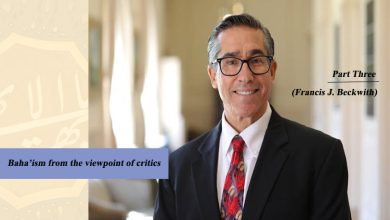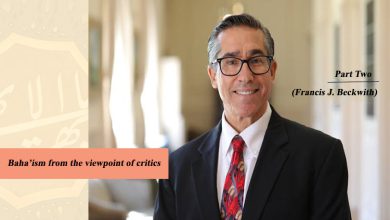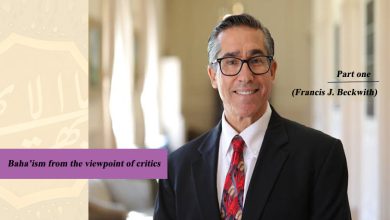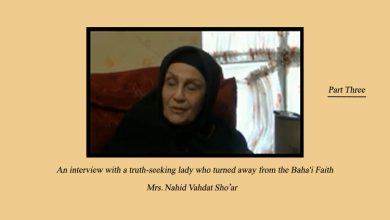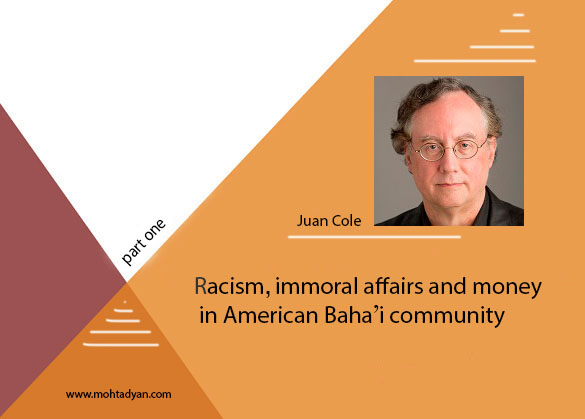
Juan Cole is one of the world’s most well-known researchers in the subject of Baha’ism. He himself was a Baha’i and has made great services to Baha’ism. He was separated from Baha’ism following extensive research and has written critical articles one of which you can read below: According to Wikipedia, John Ricardo I. “Juan Cole” (born on 23rd of October 1952) is an American contemporary scholar and historian in the area of Middle East and South Asia. At present, he is the “Richard P. Mitchell” Professor of History at the University of Michigan. Cole has written several books on modern Middle East and translates some Arabic and Persian texts into English. He who was from a Christian family, following the dispute with the Baha’i establishment, separated from the cult. He runs a weblog called Informed Comments on the address “juancole.com” which is also released in truthdig.com simultaneously.
This article reviews and analyzes the dissolution of the Assembly of Baha’is in Los Angeles by the America National assembly in the years 1986-1988. Official explanation in this regard emphasizes on the decline of moral affairs as well as the weakness of administrative discipline; but local interviews as well as some official statements consider the roots of differences in two things: 1- Globalization of the Cause Community and the resulting racial conflict between whites and African-American blacks and Iranian immigrants after the Iranian revolution. 2- National and local disputes over power and money.
Introduction:
The article’s conclusions indicates that the elections combined with a lack of information, lack of accountability of elected officials, censorship, and a reluctance to express and declare social strife, have led to such a situation in the Baha’i community. Where could Iranian-Americans and African-Americans and the whites get together, have regular meetings, worship and pray, and talk to each other? The answer is the Local Assembly of the Baha’i community in Los Angeles. A comprehensive analysis of the crisis in the Cause Community gives us a great deal of information not only about the Baha’i Faith, but also about how an imported belief has attracted the attention of many people. The National Assembly of the Baha’is in the US on 19th of July 1986 officially dissolved the Baha’i Assembly of Los Angeles, which at the time had more than 1,200 Baha’i adult members. Instead of the Local Assembly, the National Assembly officials appointed a six-member committee to report directly to the ruling party in Wilmette, Illinois, thus effectively taking direct control of the affairs of the Baha’is in Los Angeles. The Baha’is considered the measure unprecedented. However, some local assemblies have been shut down for violating the Baha’i laws, but here, this has not been the case except a minor one; So why did the National Assembly react so directly and forcefully? What were the goals of the National Assembly behind this intervention? What problems did the Los Angeles Local Assembly have that the National Assembly dissolved and recognized it as un reformable? Three issues and areas were officially addressed: financial issues, racial relations, and immorality. Some other sources believe that the supremacism and selfishness of the National Assembly was also involved.
************************
The Baha’i Faith, founded in 1863 by an Iranian named Bahaullah (1892-1817), entered the United States from the Middle East in the 1890s. Creation of world peace at the end of the times, the need for collective peace, the unity of mankind, the unity of religions, and the need for replacing authoritarian and dictatorial regimes with parliamentary systems and constitutional governments were his teachings. His son, ‘Abdu’l-Baha (1844-1921), came to the United States from 1913 to promote the Baha’i Faith. He was succeeded by the grandson of ‘Abdu’l-Baha, Shoghi Effendi (1957-1921).
Baha’i community in American
The Baha’i community in American, a relatively free, spontaneous, and liberal society with no clergy, was gradually transformed into a disciplined and organized community by religious leaders in the 1920s. The writers were asked that all writings and publications should be reviewed by the relevant agencies according to the level of their contents and scope of publication. Gradually, the Baha’is were barred from making any comments or criticisms about the functioning and policies of religious institutions. Founded in 1963 and consisting of nine members, the Universal House of Justice was considered by most American Baha’is as a community immune from any wrongdoing. The Baha’i community in the United States now probably consists of 60,000 adult men, although official statistics show that their number doubles. The date of the foundation of Los Angeles assembly goes back to the early twentieth century and its site is the graveyard of Thornton Chase, a person who is generally considered as the first American Baha’i.
As Mike Davis has said, Los Angeles is a city of conflicts and contradictions, mainly between the rich and the poor; but there are also racial and moral differences. These differences are greater in the field of religion. Los Angeles currently has a population of over 9 million (2002) and is facing immigration pressure. 106 different languages are spoken there and people from Western Europe are in the minority. Due to immigration, many problems have arisen.
If we say that the social identity emerges from the joint experience of the community, so we must say that we do not witness such thing in Los Angeles, everybody is stranger. There are many social differences and conflicts between different categories and waves of immigration, between different social groups whose weight and relative importance have changed as a result of social changes. Sri Lankan Buddhists living in Los Angeles experienced two bitter attachments in the 1970s, and Shiite and Sunni Muslims have had not so easy coexistence in Los Angeles religious meetings. Therefore, it is not surprising that the Baha’is of Los Angeles also experience problems in view of immigration waves and racial differences.
The current study is based on the interviews and talks prepared by Dialogue journal, but on the order of the Baha’i National Assembly, they were prevented to be printed and published. I myself was a member of the Baha’i community in Southern California from 1979 to 1981 and from 1983 to 1984. To better understand the situation, one must look at the power structure in the Baha’i community, which is sometimes selective or appointive.
9 members of the Local Assembly, without being run and competition, are elected directly by secret polling from among the registered persons in a specific municipal constituency or urban unit. Members of local assemblies meet each other once every 19 days while fasting. This is a mixture of spiritual affairs and official religious activity that non-Baha’is are not allowed to enter. Members of the National Assembly are elected indirectly, in this way that in the fall of each year, the Baha’is in each region elect a delegation that they elect the nine-member National Assembly in the National Convention in April of the following year. Since 1963, the convention of the national spiritual assemblies once every 5 years elects the international or universal House of Justice which is the highest executive and legislative position of the Baha’i community based in Israel’s Haifa. The Baha’i sovereignty is characterized by a structure similar to the episcopal-ecclesiastical system, as well as compliance with the requirements of the “Covenant”. The authoritarian and monopolistic nature of the upper echelons of the organization is at odds with the relative freedom of Baha’is’ practice at the lower and local levels and the Baha’i subculture in the selection of local officials.
Sometimes, the national assemblies dissolve some local assemblies whose members have been accused of corruption or are less loyal to the National Assembly. The Los Angeles Assembly faced a number of specific issues: the unusual extent and size of the city, the large Baha’i community on the American Baha’i scale, and the need to hold banquets in 13 parts of the city. These banquets increased racial and economic divisions.
dissolution of the Los Angeles Local Assembly
The dissolution of the Los Angeles Local Assembly was announced at a large Baha’i meeting held to mark the completion of the Baha’i Center by James Nelson, a member of the National Assembly when he was a judge in the Los Angeles District Court appointed by Ronald Reagan.
According to what Nelson announced, the primary reasons for this action were widespread immorality among members of the community and the inability of the assembly to resolve it. In fact, immorality was one of the reasons behind the dissolution debate, which, like many other events, was deeply linked to racial conflict in the Baha’i community. The immediate reaction of the old members of the Local Assembly was a state of shock and disbelief and its rejection. Lois Willows who was a corresponding secretary said, “I’m sure we did not do our job well. But we did our best. I feel that our problems were no bigger than those of other large Baha’i groups in the United States”. Most former members of the assembly, including all four Iranian members, declined to comment on the background of the Cause. Mrs. Manila Lee, a longtime member of the Local Assembly who was a respected African- American schoolteacher, resigned in mid-April 1986, but was re-elected on April 21 due to a slow announcement. At any rate, she believed that the dissolution should have happened a year earlier. She spoke about the 907-minute meeting of seven members of the National Assembly and members of the Los Angeles Assembly on the subject of the dissolution, chaired by James Nelson. “What happens to our prestige and character?” asked a member of the Los Angeles Assembly. “Your prestige is fading,” Nelson replied. It is understandable that members of the Local Assembly think of their credibility and prestige among members of the Baha’i community.
Nelson’s verbal announcement of the dissolution was followed by sending a letter from Robert Henderson, Secretary-General of the National Spiritual Assembly, to the Baha’is of Los Angeles.
Henderson, an African- American Baha’i
Henderson, an African- American Baha’i formerly engaged in business, was raised in a Baha’i family in Los Angeles and was elected as a member of the National Assembly in 1984; Therefore, these events were meaningful for him.
Henderson wrote: “After lengthy and annoying consultations, the National Assembly concluded that the condition required surgery and repair.” The first act for dissolving the assembly happened on July 19. He added that the most important reason for this unpleasant but necessary action was the inability of the Local Assembly to meet the needs of the Baha’i community in spiritual and executive matters.
He explained that in order to rebuild the Baha’i community in Los Angeles, the US National Assembly appointed an executive committee with which the Baha’is have to cooperate and assist as much as possible. Finally, he recalled a sentence from ‘Abdu’l-Baha addressed to the early Baha’i community in Los Angeles according to which he had asked them to propagate the Baha’i Faith among the people, and stand firm in the Covenant that most Baha’is interpret it as unconditional obeying and submission before the Baha’i episcopal and executive authorities.
Members of the six-person executive committee had been selected from neighboring assemblies, but to train local people to run for office and elect a local assembly in the future, nine people were appointed to serve on the Council of nineteen local Baha’is to oversee propaganda, administrative, financial, and day-to-day activities and proclamation activities of the Los Angeles Bahia Community in August 1986.
At the Feast of Asma on 19 August, long-time National Assembly member Firuz Kazemzadeh and then professor of Russian history at Yale University was asked when fresh elections for a Local Assembly would be held and replied that it perhaps will be determined through a process of consultation between the Council of 19, the administrative committee, the community at large and the National Assembly. It cannot be decided locally. It will be decided jointly.
Mark Sisson Baha’i
The Dialogue magazine interviewed Mark Sisson, who had served on the Local Assembly of Los Angeles from 1983 till 1984, when he had resigned in frustration, and who was the only former Local Assembly member to be appointed to the Council of Nineteen. He explained that the Council of 19 are trainees, as it were, in preparation for assembly members.
It was expected that local Baha’i s with leadership potential would be rotated onto the Council of Nineteen to create a wider base of administrative experience. However, Sisson expressed concern about the publication of the pictures of the Council of Nineteen on the cover of the September issue of the Los Angeles Baha’i Journal. In Baha’i elections, campaigning and canvassing are supposed to be strictly forbidden, and this photograph appeared to many to function as a subtle campaign poster. Sisson admitted, this is a concern of many of the council members themselves. And this has been voiced by myself and others. I have been really concerned about this issue . I was very uncomfortable with the fact that our pictures were plastered all over the journal. I am concerned with the fact that we are constantly referred to as council members before the community at large. However, it is premature to say whether or not the outcome will be, another crude form of electioneering. It will result in that if the Baha’i community at large does not pursue their individual and independent responsibility as active members of the community.
In fact, the techniques of subtle campaigning had long been mastered by several members of the National Assembly, who had become perpetual incumbents, so the spread of these tactics to a large urban community is not surprising.
Around the same time as the Local Assembly was dissolved, one of its members, an Iranian refugee and ex-academic, faced possible Baha’i administrative sanctions over alleged financial irregularities in his business. This simultaneity of charges raised the question of whether the businessman’s actions had helped precipitate the National Assembly’s intervention. A Dialogue correspondent wrote to Anna Lee Strasburg, head of community affairs at the national Baha’i center in Wilmette, Illinois, asking, among other things, whether it were true that: the National Assembly discussed the possibility of dissolving the Local Assembly of Los Angeles as early as 1983; the Universal House of Justice advised the National Assembly not to postpone the dissolution; the timing of the sanctions against the Iranian businessman and the dissolution of the Local Assembly was coincidental. That these questions were being widely posed in the community at the time demonstrates that local Baha’is were seeking to establish some timeline and chain of authority for the dissolution.
Only months later, on March 14, 1987, did the general community receive a more extended explanation of what had happened, during a talk given at the local Baha’i center by National Assembly Secretary Robert Henderson. He expressed regret that the National Assembly had felt forced to intervene, acknowledging that Baha’i values favored emphasizing the good points in an individual or body.
Study the continuation of the article in
part two …
part three


